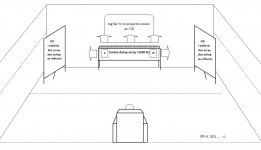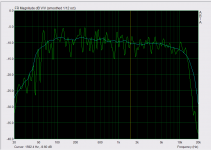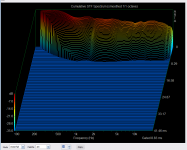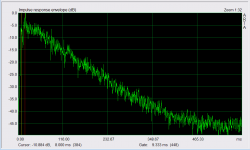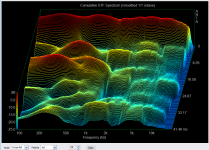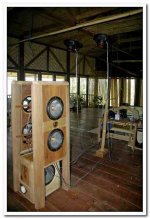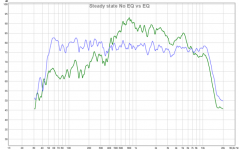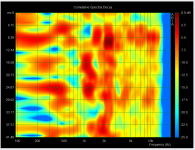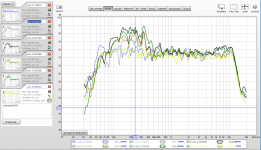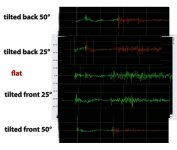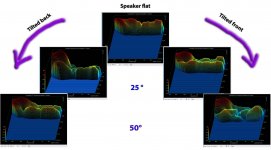Upgrading the stereolithic projection. Removal of the pillow direct sound blocker. Low freqs are handled by crossed dipoles ! This way it is possuble to set the required level of direct sound attenuation by toeing the dipoles. The attenuation is possible through the whole audio band. High freqs handled by side firing box system.
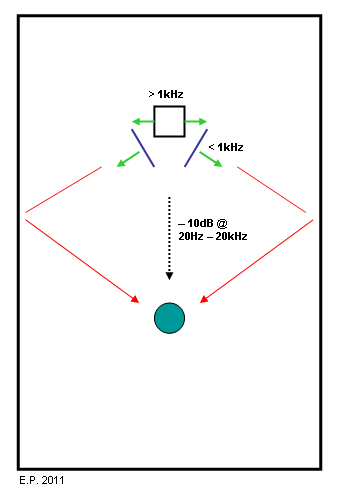
- Elias
but is the postulated high directivity <1 kHz realized in such a setup?
Last edited:
but is the postulated high directivity <1 kHz realized in such a setup?
Funny, I was more interested in how he was going to achieve the higher freq. pattern.
If side-firing conventional domes are used one gets mainly direct sound up to about 5 kHz and someone who is as good in source localization as Elias will probably be able to localize them.
That's the problem.
-up to 5 kHz it's much less directional, which is the opposite premise of having and frontal "blocker" like his sofa pillow. The dipoles aimed the way he has them in the figure do provide a null to the front, but getting a conventional tweeter to do that is something else.
Toole's opinion on early reflections is not really that simple. I quote from a studio designer on a Dutch forum who asked Floyd himself:
"Hi Bert.
People who say I dismiss room reflections as unimportant - and there are a few, it seems - simply have not read or understood my book. It is patently obvious that room treatment is necessary, if only to establish conditions suitable for comfortable conversation. This requires reverberation times under 0.5 second. This alone, also pretty much ensures that film dialog will be clearly understood.
The most debated issue relates to first lateral reflections. Some of those arguing vociferously in favor of eliminating them seem to have a conflict of interest, being providers of acoustical materials. Others have more reasoned arguments. I say up front that there can be no universally satisfactory answer because there is no universal scheme for recording stereo or multichannel signals. Only through controlled listening tests can we get useful insights, and these are in short supply. In the meantime opinions reign supreme, and there are many of them.
In the book I show results of several double-blind evaluations, some done by me, some done by others, showing that listeners tend not to be disturbed by lateral reflections, and many even prefer them. I also point out that the professional side of the industry almost universally feels the need to eliminate them. I suggest, respectfully, that humans have a remarkable ability to learn, to adapt, and that recording engineers spending their days adding, adjusting, and removing - at will - delayed sounds from mixes undoubtedly are more highly sensitized to these sounds than are lay listeners. This probably applies to any audio professional, acoustical consultant or enthusiast who focuses enough attention on this task. We learn to hear things and, once heard, they tend not to go away. I well remember that during the resonance detection experiments, we all became extremely skilled at hearing and identifying resonances. During the tests, and for some time afterward, we were hearing little resonances in everyday life that normally would have been totally unnoticed. From such things paranoia is born, and if we had taken this to an extreme, we would have damped our wine glasses.
For stereo listening I have found that it very much depends on the program. Music with lots of decorrelated sounds, classical for example, is sometimes enhanced by reflections, although coincident-mic recordings may benefit from a lack of reflections - letting the direct sounds be more dominant (the Blumlien stereo effects work best in an almost anechoic situation). Pan-potted recordings (the majority of pop) end up delivering essentially monophonic sounds from left and right loudspeakers, and these may well benefit from a bit of spatial enhancement. Otherwise we are left with what really annoys me about stereo: a relatively spatial set of phantom images created by both loudspeakers, and two "anchor" images created by the left and right loudspeakers playing solo. In some recordings we hear a whole string section emerging from a single loudspeaker. Not realistic, and not even pleasant. In the past, I have recommended that serious stereo listeners hang absorbent drapes along each side wall, pulling them out and pushing them back to suit what they are listening to. Our listening room at the National Research Council in Canada had this feature.
In the book, I put more emphasis on multichannel audio, where much of the important sound is delivered by the center loudspeaker, farthest from the side walls. In these situations I conclude that treatment of the side wall reflections is an option. There may be situations in which their effects are audible, but when all 5 or 7 channels are operating, it is improbable that natural room reflections have much of an effect. Other things being equal, the effects of the room are most audible when only a single loudspeaker is operating, and it becomes less so as other loudspeakers (channels) contribute additional uncorrelated sounds.
Of course the degree to which reflections are activated depends on the directional properties of loudspeakers, and the extent to which the loudspeakers are well behaved in their far off-axis responses (side wall reflections can be 50 degrees and more off axis). It has become clear over the years that, with hard side walls, the more uniform the off axis frequency response, the higher the rating of the loudspeaker. So, one has to wonder whether at least some of the dissatisfaction with reflective side walls has to do the misbehaving loudspeakers. Sadly, most manufacturers don't provide us with sufficient data to judge. And that is another, and I would argue much more worthy topic, to argue about.
Best wishes,
Floyd"
an insightful opinion that is worth reposting in this thread too
underline mine - check it out Elias! it seems that Dr Toole has problem with hearing phantoms as well
My Carlssons with a directivity pattern most people in this forum would call weird have the ability to disappear even if playing mono and I think it is exactly that "weird" directivity pattern is responsible for that. I think you'll never have believable phantom images with speakers that don't disappear in mono operation.
3 experiences
In despite of my deficient hearing, my improper room and as a result my approximative speakers, I've done some acoustical funny tests.
"The" driver is an indonesian made 12" with a mega wizzer. It's filmsy coil and 39 g mms claim 15000 Hz. Its other great quality is it's price (33 euros for both).
As the goal of this game is only comparative, the configuration "naked driver" + digital equalisation will be enough. Of course, without EQ, it's a nightmare. They are also extremely directive in the HF.
Experience 1 :
Swinging drivers, 1 m high, equilateral triangle 4.5 meters. Drivers vertical, either full in my face, either toed in just in front of me.
Surprisingly good in tune (I'm not a FR fan normally), but the pattern is two sources + sometimes something in the middle. No envelopment, ambient, perspective, depth, whatever...
The test of the passing train is reduced to a brutal switch left to right. Test on pink noise, as always with this config : HF dichotomy.
For this reason, a strong toe out works better
Some will say that with such a primitive setting this failure is not a surprise. But wait for these primitive when disposed differently.
Experience 2 :
Same drivers, same EQ, this time simply put on the floor, as close as possible from the back boundary, 4.5 m from each other, 6 meters from the listener.
Since a while I wanted to verify this, to make sure that graaf or tinitus were not too sick.
Result : it's shocking when considering that it's the same drivers than 1 minute ago. All the claims of these gentlemen are real, with the drivers set up like a flower pot (but decoupled from the floor with thick rubber).
Not only the soundstage occupies all the wall (9 meters here) but there is eventually a strong center presence, it's ok for girl and guitar as for giant choruses or symphony. The trains circulate progressively. I insist it's not a mess up.
The Hf is not perceptually reduced (- 2 dB roll off at measure), and that's puzzling because the part over 2500 Hz stays in a 10° cone @ 0 dB. Even with one only running, the source is unlocalizable. Subs are not mandatory except for organ.
For me, adept of multi ways-multi amped systems, this is a double bottom kick : the flooder and the FR. Just the envelopment and perspective are not very good, all this is a kind of 2D image. But for 33 euros...
joined plots : > steady state of the flooder from 6 meters
> CDS with short gate (ok, it's 1/1 smoothed and has a lazy decay, but could be much worse)
> ETC with sub on (mistake), no floor bounce, the 9.33 ms peak is the side wall.
Experience 3 :
Same drivers, but now almost stuck by the magnet, back to back. You will all recognize a side firing, but it's also a linear quadrupole. The big novelty is that this time the drivers are only at 1 meter in front of the listener in the horizontal plane. But in the vertical plane they are 3 meters high, and still far from the ceiling. The test starts after a slightly adaptation of the EQ.
Result : baffling ! The flooder config was not localizable, but at least, the sound came from a logical direction : in front, where the drivers are.
Here, the sound still comes from the front, normal height, but the speakers are at 6 meters from this. So much that I had to call the wife to make it sure that I was not going mad. These speakers are only localizable when watching them or standing up and walking around. Extremely tricky ! It's really in the acoustical illusion domain.
The restitution style is globally close from the flooder but complementary : more envelopment, but missing the beautiful center presence.
A good idea could be a combination of both : flooder + glider(!), trivial, one for the center, one for the sides (envelopment), all this with some wood around the drivers and a DSP able to control their respective EQ and delay.

In despite of my deficient hearing, my improper room and as a result my approximative speakers, I've done some acoustical funny tests.
"The" driver is an indonesian made 12" with a mega wizzer. It's filmsy coil and 39 g mms claim 15000 Hz. Its other great quality is it's price (33 euros for both).
As the goal of this game is only comparative, the configuration "naked driver" + digital equalisation will be enough. Of course, without EQ, it's a nightmare. They are also extremely directive in the HF.
Experience 1 :
Swinging drivers, 1 m high, equilateral triangle 4.5 meters. Drivers vertical, either full in my face, either toed in just in front of me.
Surprisingly good in tune (I'm not a FR fan normally), but the pattern is two sources + sometimes something in the middle. No envelopment, ambient, perspective, depth, whatever...
The test of the passing train is reduced to a brutal switch left to right. Test on pink noise, as always with this config : HF dichotomy.
For this reason, a strong toe out works better
Some will say that with such a primitive setting this failure is not a surprise. But wait for these primitive when disposed differently.
Experience 2 :
Same drivers, same EQ, this time simply put on the floor, as close as possible from the back boundary, 4.5 m from each other, 6 meters from the listener.
Since a while I wanted to verify this, to make sure that graaf or tinitus were not too sick.
Result : it's shocking when considering that it's the same drivers than 1 minute ago. All the claims of these gentlemen are real, with the drivers set up like a flower pot (but decoupled from the floor with thick rubber).
Not only the soundstage occupies all the wall (9 meters here) but there is eventually a strong center presence, it's ok for girl and guitar as for giant choruses or symphony. The trains circulate progressively. I insist it's not a mess up.
The Hf is not perceptually reduced (- 2 dB roll off at measure), and that's puzzling because the part over 2500 Hz stays in a 10° cone @ 0 dB. Even with one only running, the source is unlocalizable. Subs are not mandatory except for organ.
For me, adept of multi ways-multi amped systems, this is a double bottom kick : the flooder and the FR. Just the envelopment and perspective are not very good, all this is a kind of 2D image. But for 33 euros...
joined plots : > steady state of the flooder from 6 meters
> CDS with short gate (ok, it's 1/1 smoothed and has a lazy decay, but could be much worse)
> ETC with sub on (mistake), no floor bounce, the 9.33 ms peak is the side wall.
Experience 3 :
Same drivers, but now almost stuck by the magnet, back to back. You will all recognize a side firing, but it's also a linear quadrupole. The big novelty is that this time the drivers are only at 1 meter in front of the listener in the horizontal plane. But in the vertical plane they are 3 meters high, and still far from the ceiling. The test starts after a slightly adaptation of the EQ.
Result : baffling ! The flooder config was not localizable, but at least, the sound came from a logical direction : in front, where the drivers are.
Here, the sound still comes from the front, normal height, but the speakers are at 6 meters from this. So much that I had to call the wife to make it sure that I was not going mad. These speakers are only localizable when watching them or standing up and walking around. Extremely tricky ! It's really in the acoustical illusion domain.
The restitution style is globally close from the flooder but complementary : more envelopment, but missing the beautiful center presence.
A good idea could be a combination of both : flooder + glider(!), trivial, one for the center, one for the sides (envelopment), all this with some wood around the drivers and a DSP able to control their respective EQ and delay.

Attachments
Last edited:
Bernard, what you describe is the whoa effect that one has when listening to a symphony orchestra for the first time. Strong early reflections, louder than the direct sound.
Aim the drivers in 2) so they hit the first reflection point at the ceiling - you'll hear sounds coming from there.
Could you post or email the IR of setup 2?
Aim the drivers in 2) so they hit the first reflection point at the ceiling - you'll hear sounds coming from there.
Could you post or email the IR of setup 2?
Nice experiments, Radu!
The steady state plot of the flooder tells me two things:
1. I truely believe that such a well balanced response sounds nice - regardless whether it originates from a flooder or a direct radiator.
2. The same plot tells me, that this same driver must be a screaming monster when pointed directly (or almost directly) at your face. And yes, tweeters which are much to loud and/or distorting - compared to the rest, can "glue" the image to the loudspeakers.
Rudolf
The steady state plot of the flooder tells me two things:
1. I truely believe that such a well balanced response sounds nice - regardless whether it originates from a flooder or a direct radiator.
2. The same plot tells me, that this same driver must be a screaming monster when pointed directly (or almost directly) at your face. And yes, tweeters which are much to loud and/or distorting - compared to the rest, can "glue" the image to the loudspeakers.
Rudolf
@ markus : you mean aiming the drivers to the midway listener ceiling ? So the path is driver/ceiling/listener ? Maybe it could work as you think if my ceiling was flat (slopped) and was with hard and reflecting surface...it's different here.
BTW, you read in my mind because these drivers are actually almost in this position (but 2 m50 high and swinging, almost touching each other). But they are behind me, incorporated to my ordinary system. Wiring is also exclusive : each driver is connected between the + of the HF amp and the + of the Mid amp (this can deserve a huge development). I only can estimate their own response in near field.
All this looks dumb (ah the whoa effect ! you know, I don't try to understand, I listen only) but produces stronger center clues, the big problem of a side firing. Incidentally, there is a secondary surround effect : I have a record of plane (B25) flying over the mikes, but in their axis (not in lateral translation), with this, there is a clear back to front move. Without these drivers, this stays stuck in front. Traduction of a Doppler effect ? Applauses are also more enveloping, this was a big problem.
No IR sorry , only the ETC, but trust me this IR from the list spot was really a total mess up. The strangeness is the clear and sharp (with HF content then) side wall reflection with a device that shoots vertically. An analyse with stethoscope shows clearly the dipole pattern (nothing in the gasket plane) and the extreme directivity of the HF.
@ Rudolf : screaming monster ! I was thinking of a good rat repellent. Of course, with such a big wizzer and without baffling, it's not a reference for on axis smoothness, hence the projection effect. My subjective tests have only a comparative value for this case, not for a generalization.
PS : the CSD are 1/1 and Hanning window for the beauty of the picture , with less smoothening it's a real porcupine. Just representative of the general balance.
joined docs : > the on axis CSD of the facing & swinging driver (1/1, 4.50 m, no gate). It's not an anechoic room.
> these heroic drivers as they were this morning (speakers behind the listener)
BTW, you read in my mind because these drivers are actually almost in this position (but 2 m50 high and swinging, almost touching each other). But they are behind me, incorporated to my ordinary system. Wiring is also exclusive : each driver is connected between the + of the HF amp and the + of the Mid amp (this can deserve a huge development). I only can estimate their own response in near field.
All this looks dumb (ah the whoa effect ! you know, I don't try to understand, I listen only) but produces stronger center clues, the big problem of a side firing. Incidentally, there is a secondary surround effect : I have a record of plane (B25) flying over the mikes, but in their axis (not in lateral translation), with this, there is a clear back to front move. Without these drivers, this stays stuck in front. Traduction of a Doppler effect ? Applauses are also more enveloping, this was a big problem.
No IR sorry , only the ETC, but trust me this IR from the list spot was really a total mess up. The strangeness is the clear and sharp (with HF content then) side wall reflection with a device that shoots vertically. An analyse with stethoscope shows clearly the dipole pattern (nothing in the gasket plane) and the extreme directivity of the HF.
@ Rudolf : screaming monster ! I was thinking of a good rat repellent. Of course, with such a big wizzer and without baffling, it's not a reference for on axis smoothness, hence the projection effect. My subjective tests have only a comparative value for this case, not for a generalization.
PS : the CSD are 1/1 and Hanning window for the beauty of the picture , with less smoothening it's a real porcupine. Just representative of the general balance.
joined docs : > the on axis CSD of the facing & swinging driver (1/1, 4.50 m, no gate). It's not an anechoic room.
> these heroic drivers as they were this morning (speakers behind the listener)
Attachments
@ markus : you mean aiming the drivers to the midway listener ceiling ? So the path is driver/ceiling/listener ? Maybe it could work as you think if my ceiling was flat (slopped) and was with hard and reflecting surface...it's different here.
I see. You could mount two wooden boards which would make it easier to find the correct spot. I'm curious if you also experience the breakdown of precedence at higher frequencies and not just added spaciousness.
No IR sorry , only the ETC, but trust me this IR from the list spot was really a total mess up.
Can you send me the impulse response of your measurement as a sound file?
Here are some revelations about the flooder's secret life.
First point : Nothing easier than put a naked driver on the floor, but the reproductivity of two measurement sessions is highly compromised, because a flooder placement is very critical. +/- 2 centimeters and monstrous dips and notches appear, even with 1/1 smoothening, it's impossible to get a flat CSD with a similar steady state curve.
As a proof of the malediction, look at the CDS ladder. The never seen before transversal ridge appears because of a 20 cm displacement. The dimension of the difficulty is best seen with the next plot, the raw driver before and after massive equalisation.
First point : Nothing easier than put a naked driver on the floor, but the reproductivity of two measurement sessions is highly compromised, because a flooder placement is very critical. +/- 2 centimeters and monstrous dips and notches appear, even with 1/1 smoothening, it's impossible to get a flat CSD with a similar steady state curve.
As a proof of the malediction, look at the CDS ladder. The never seen before transversal ridge appears because of a 20 cm displacement. The dimension of the difficulty is best seen with the next plot, the raw driver before and after massive equalisation.
Attachments
Second point : after choosing an arbitrary position, and doing my best to have something presentable and listenable, the question is What is the influence of the driver oblique orientation ? I did only the frontal plane.
On the FR plots (REW window) tilts of 25 & 50°. (flat driver, 25° front, 50° front, 25° back, 50° back and 35° back with EQ adaptation).
Surprise, the HF level stays unchanged, but the 100/400 Hz zone is very affected. Not very clear here except on the lateral thumbnails, but tilted frontward or back ward it's almost the same effect. The frontward tilt (thumbs 2 & 3) show a slightly increase of the HF.
The explanation is maybe the dipole null that is very neat in the lower octaves. When tilting, the mike see more the reflected image of a lobe (front or rear). Or the cancellation was boosted by the flat floor ?
Practically, this allows less EQ gain and then a better headroom.
HF are not very concerned because of the extreme directivity of the driver. Any way the sharp limit of the boosted low freq is very intriguing.
On the FR plots (REW window) tilts of 25 & 50°. (flat driver, 25° front, 50° front, 25° back, 50° back and 35° back with EQ adaptation).
Surprise, the HF level stays unchanged, but the 100/400 Hz zone is very affected. Not very clear here except on the lateral thumbnails, but tilted frontward or back ward it's almost the same effect. The frontward tilt (thumbs 2 & 3) show a slightly increase of the HF.
The explanation is maybe the dipole null that is very neat in the lower octaves. When tilting, the mike see more the reflected image of a lobe (front or rear). Or the cancellation was boosted by the flat floor ?
Practically, this allows less EQ gain and then a better headroom.
HF are not very concerned because of the extreme directivity of the driver. Any way the sharp limit of the boosted low freq is very intriguing.
Attachments
Third point : the IR variations.
The scale of the plot is 5 ms/square. Here it's now very different. As expected, there is a transfer of energy to the direct impulse when tilted frontward, and symmetrically a transfer to the first reflective surface (back wall) when tilted backward.
On the two extreme, the impulse tail is more clean and we recognize the side wall reflection (first neat artifact at around 8 to 10 ms). On the two back tilted, I suspect that the 100/400 Hz boost generates a big floor bounce (I forget to check this with the EQed one).
The curious guys (...) can DL the IR wav files, replace .zip by .wav
The scale of the plot is 5 ms/square. Here it's now very different. As expected, there is a transfer of energy to the direct impulse when tilted frontward, and symmetrically a transfer to the first reflective surface (back wall) when tilted backward.
On the two extreme, the impulse tail is more clean and we recognize the side wall reflection (first neat artifact at around 8 to 10 ms). On the two back tilted, I suspect that the 100/400 Hz boost generates a big floor bounce (I forget to check this with the EQed one).
The curious guys (...) can DL the IR wav files, replace .zip by .wav
Attachments
flooder is OT in this stereolitic thread, here is the original flooder thread: http://www.diyaudio.com/forums/multi-way/121385-loudspeakers-room-system-158.html
Fourth point : CSD
I admit that the flat position is not a beauty, but it's a comparative test. I don't have to comment a lot, the images speak by themselves.
Naturally, we see that the reflected impulse becomes more and more important.
From my subjective experience with the side firing, I can say that this reflection is predominant for the voicing of the system, could it be rejected at 20 ms. Maybe this is the breakthrough precedence ?
If I had to choose a sound between these five possibilities, no hesitation, I take the titled back 50°. The two ridges are grossly similar, well differenciated. The notch @ 350 Hz will be covered by the direct sound. The mega LF boost can be reduced (positively !) by less gain in the EQ.
The 25 front will sound harsh, the 25 back has little interest (where's the direct sound ?) and the 50° frontward is an horror. Strangely, this one is the closest related to a direct firing setup...

 .
.
All this being done for listening, I confirm that effectively the 50°/35° tilted back overruns the rest.
Please don't ask for polars...
I admit that the flat position is not a beauty, but it's a comparative test. I don't have to comment a lot, the images speak by themselves.
Naturally, we see that the reflected impulse becomes more and more important.
From my subjective experience with the side firing, I can say that this reflection is predominant for the voicing of the system, could it be rejected at 20 ms. Maybe this is the breakthrough precedence ?
If I had to choose a sound between these five possibilities, no hesitation, I take the titled back 50°. The two ridges are grossly similar, well differenciated. The notch @ 350 Hz will be covered by the direct sound. The mega LF boost can be reduced (positively !) by less gain in the EQ.
The 25 front will sound harsh, the 25 back has little interest (where's the direct sound ?) and the 50° frontward is an horror. Strangely, this one is the closest related to a direct firing setup...
All this being done for listening, I confirm that effectively the 50°/35° tilted back overruns the rest.
Please don't ask for polars...
Attachments
- Status
- This old topic is closed. If you want to reopen this topic, contact a moderator using the "Report Post" button.
- Home
- Loudspeakers
- Multi-Way
- Stereolith Loudspeakers Question
